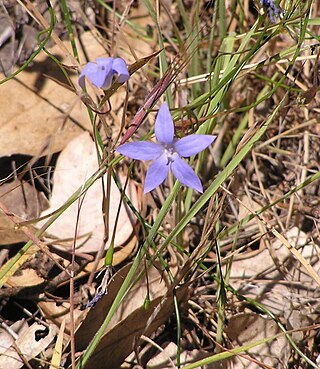
Wahlenbergia is a genus of around 260 species of flowering plants in the family Campanulaceae. Plants in this genus are perennial or annual herbs with simple leaves and blue to purple bell-shaped flowers, usually with five petals lobes. Species of Wahlenbergia are found on all continents except North America, and on some isolated islands, but the greatest diversity occurs in the Southern Hemisphere.

Gasteria is a genus of succulent plants, native to South Africa and the far south-west corner of Namibia.

Protea eximia, the broad-leaved sugarbush, is a shrub from South Africa that may become a small tree. It occurs in mountain fynbos on mainly acidic sandy soils; the species was very well known under its old name of Protea latifolia. The flowers have awns that are covered in purple-black velvety hairs, and are contained within a series of rings of involucral bracts that have the appearance of petals. The fruit is a densely hairy nut, many of which are inserted on a woody base. The flowers are borne terminally on long shoots, and have a tendency to become very untidy as they age.
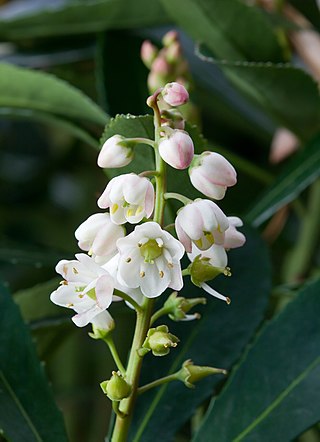
Anopterus glandulosus, commonly known as native laurel or Tasmanian laurel, is a species of shrub or small tree in the family Escalloniaceae. Endemic to south and southwestern Tasmania, A. glandulosus is widespread in the moist understoreys of Tasmanian temperate rainforests and wet sclerophyll forests from sea level to mountainous regions below 1,200 metres (3,937 ft) above sea level.

AnacampserosL. is a genus comprising about a hundred species of small perennial succulent plants native to Southern Africa, Ethiopia and Latin America. The botanical name Anacampseros is an ancient one for herbs supposed to restore lost love.
Tetragonia nigrescens is a plant native to southern Africa.

Crassula subaphylla is a succulent plant belonging to the family Crassulaceae. It is widespread in the Karoo regions of South Africa and Namibia.
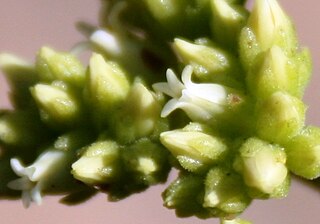
Crassula atropurpurea is a succulent plant, very common and widespread in the southern Karoo regions of South Africa and Namibia.

Wahlenbergia capensis, commonly known as the Cape bluebell, is a plant in the family Campanulaceae and is native to the Cape Province but has been introduced to Australia. It is an annual herb with up to four greenish blue, bell-shaped flowers with spreading petal lobes.

Bartholina burmanniana, the spider orchid, is a species of deciduous, geophytic, flowering plant in the family Orchidaceae. It is one of two species within the Bartholina genus, the other being B. etheliae. The species’ common name refers to its spreading and deeply cut lip that is said to resemble a spider's legs. It is native to the Eastern and the Western Cape Provinces of South Africa, flowering from the end of August to the middle of October and peaking in September. This is one of the species sometimes referred to as "spider orchid".

Dianthus basuticus, called the Drakensberg carnation, Lesotho carnation, Lesotho pink, hlokoa‑la‑tsela in the Sesotho language and Lesothose wilde angelier in Afrikaans, is a species of Dianthus native to South Africa and Lesotho.

Dianthus thunbergii is a species of flowering plant in the family Caryophyllaceae.

Dudleya cymosasubsp. cymosa is a species of succulent perennial plant in the family Crassulaceae native to California. It is the autonymous subspecies for Dudleya cymosa, and is known by the common name canyon liveforever. It is native to the California Coast Ranges, the Sierra Nevada and the Santa Monica Mountains. It is characterized by bright-yellow, orange or red flowers and broad, wide leaves. This plant is commonly found growing on rocky outcrops, talus slopes, and in shaded canyons.
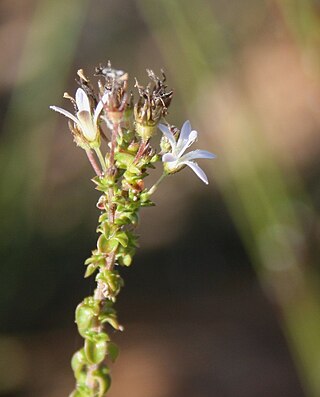
Wahlenbergia tenella is a herbaceous plant in the family Campanulaceae native to the southern Cape regions of South Africa.

Wahlenbergia nodosa is a herbaceous plant in the family Campanulaceae native to the dry karoo regions of South Africa.

Gazania pectinata, the cockscomb Gazania, is a species of flowering plant in the family Asteraceae, native to the lower-lying regions and coastal plains of the Western Cape Province, South Africa.

Gazania serrata is a species of flowering plant in the family Asteraceae, native to the Northern Cape and Western Cape provinces, South Africa.
Helichrysum sphaeroideum is a species of flowering plant in family Asteraceae. It is native to the Cape Provinces of South Africa.
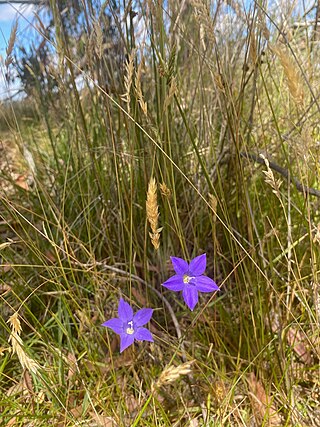
Wahlenbergia gymnoclada, commonly known as the naked bluebell, is a species of plant of the family Campanulaceae and is native to Australia. It is one of 200 species, in the Wahlenbergia genus. Of these species, 26 occur in Australia, including one introduced, and Tasmania has seven species of native Wahlenbergia. Species in this genus are “all slender perennial herbs and most species occur in grassy vegetation, although one occurs in rocky alpine areas. “The slender pedicels with delicate blue, symmetrical, flowers make this a relatively distinctive genus. The corolla tube is bell shaped, often with more or less spreading lobes”.

















